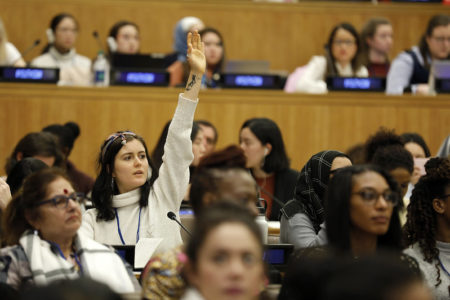
Despite decades of progress in closing the gender equality gap, close to nine out of 10 men and women around the world, hold some sort of bias against women. (UN Women / Creative Commons)
From Ms. Magazine. https://tinyurl.com/t39c57t
Despite decades of progress in closing the gender equality gap, almost nine out of 10 men and women around the world hold some sort of bias against women, according to new findings published on Thursday from the UN Development Programmme (UNDP).
The first of its kind, the UNDP Gender Social Norms Index analyzed data from 75 countries collectively home to more than 80 percent of the global population.
“The work that has been so effective in ensuring an end to gaps in health or education must now evolve to address something far more challenging: a deeply ingrained bias—among both men and women—against genuine equality,” said UNDP Administrator Achim Steiner, adding “current policies, while well intentioned, can only take us so far.”
Overall Attitudes About Women and Men
Almost half of poll participants feel that men are superior political leaders, and over 40 percent believe men make better business executives and are more entitled to jobs when the economy is lagging.
Moreover, 28 percent think it is justified for a man to beat his wife.
People’s expectations of individuals’ roles in households, communities, workplaces and societies can determine a group’s functioning. Women often face strong conventional societal expectations to be caregivers and
homemakers; men are expected to be breadwinners. Embedded in these social norms are longstanding patterns of exclusion from household and community decision-making that limit women’s opportunities and choices.
So, despite convergence on some outcome indicators—such as access to education at all levels and access to health care—women and girls in many countries still cannot reach their full potential.
Country-by-Country Breakdowns
The study found no countries in the world have gender equality.
Zimbabwe had the highest amount of bias with only 0.27 percent of people reporting no gender bias at all. In Zimbabwe, 96 percent of people expressed a bias against women’s physical integrity—a measure covering support for violence against women and opposition to reproductive rights.
Andorra had the most promising results: 72 percent of Andorrans reported no bias.
For context, 46 percent of women in the U.S. reported no bias, compared with 39 percent of men.
In the Philippines, 91 percent of people held views that were detrimental to women’s physical integrity.
View the entire Gender Social Norms Index data tables here.
Achieving Gender Parity is a Long Way Off
“We have come a long way in recent decades to ensure that women have the same access to life’s basic needs as men,” said the head of UNDP’s Human Development Report Office, Pedro Conceição. “We have reached parity in primary school enrollment and reduced maternal mortality by 45 percent since the year 1990.”
But, as Conceição conceded, “Gender gaps are still all too obvious in other areas, particularly those that challenge power relations and are most influential in actually achieving true equality.”
While men and women vote at similar rates, only 24 percent of parliamentary seats worldwide are held by women and there are only 10 female heads of government out of 193 Member States.
Furthermore, women are paid less than men working the same jobs and are much less likely to be in senior positions.
According to the data, less than six percent of chief executive officers in S&P 500 companies are women. And while they work more hours than men, their work is more likely to be unpaid care labor.
So while women’s overall employment might be close to parity, women are drastically underrepresented in more senior positions.
A Disappointing Shift Backwards
The analysis also highlighted a disappointing bias shift in some 30 countries, revealing that while some show improvements, attitudes in others appear to have worsened in recent years—a signal progress cannot be taken for granted.
The Human Development Report’s Gender Inequality Index (GII)—a measure of women’s empowerment in health, education and economic status—shows that overall progress in gender inequality has been slowing in recent years.
In short: the world is not on track to achieve gender equality by 2030. Based on current trends, it would take 257 years to close the gender gap in economic opportunity. The number of female heads of government is lower today than five years ago, with only 10 women in such positions among 193 countries—down from 15 in 2014.
“The fight about gender equality is a story of bias and prejudices,” said Conceição.
The 25th Anniversary of the Beijing Declaration and Platform for Action—and the Path Forward
UNDP pointed out that 2020 marks the 25th anniversary of the Beijing Declaration and Platform for Action (Beijing+25), the most visionary agenda on women’s empowerment to date that called on world leaders to accelerate action to meet global targets on gender equality.
The UN agency is urging governments and institutions to utilize new policies to change these discriminatory beliefs and practices through education, and by raising awareness and changing incentives.
For instance, taxes can be used as an incentive for sharing child-care responsibilities, or women and girls can be encouraged to enter traditionally male-dominated sectors, such as the armed forces and information technology.
“The women’s rights demonstrations we’re seeing across the world today, energized by young feminists, are signaling that new alternatives for a different world are needed,” said UNDP Gender Team Acting Director Raquel Lagunas. “We must act now to break through the barrier of bias and prejudices if we want to see progress at the speed and scale needed to achieve gender equality and the vision laid out in the Beijing Declaration over two decades ago and the Sustainable Development Goals.”
A link to the full report can be viewed here.

